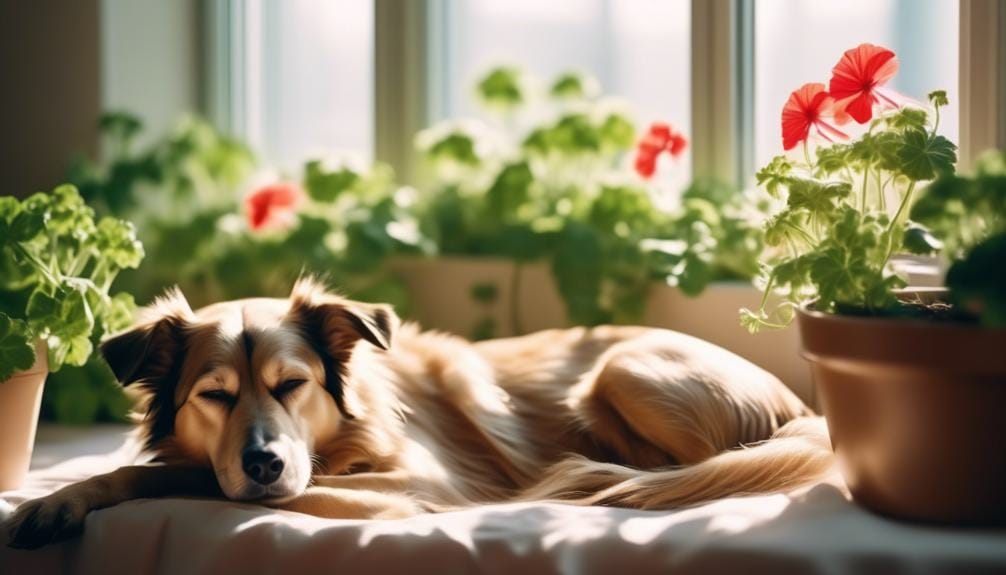Are Geraniums Bad for Dogs? Understanding Pet Safety
You might not be aware that the vibrant geraniums adorning your garden could pose a hidden danger to your furry friend. Geraniums are indeed toxic to dogs, and their ingestion can lead to a spectrum of unpleasant symptoms ranging from mild gastrointestinal upset to severe skin irritation. If your dog happens to chew on these plants, they might experience vomiting, diarrhea, lethargy, or even more alarming signs such as difficulty breathing, which signals a more serious reaction.
The severity of these symptoms often depends on the amount ingested and your dog’s overall health. As a responsible pet owner, it’s crucial to recognize these signs early and know the immediate steps to take, ensuring your dog’s safety. This introduction serves as an essential guide to understanding the risks geraniums pose to dogs, highlighting the importance of vigilance in preventing accidental ingestion.
To safeguard your pet’s health and maintain a beautiful, yet safe, garden, let’s explore further how to identify symptoms, what actions to take in case of poisoning, and safer plant alternatives to beautify your outdoor space without compromising your dog’s well-being.
Key Takeaways
- Geraniums are toxic to dogs and can cause gastrointestinal upset and skin irritation.
- Recognizing the symptoms of geranium poisoning in dogs is important for their safety.
- Immediate actions for geranium poisoning include isolating the dog, monitoring for distress, and seeking veterinary assistance.
- Treatment and recovery for geranium poisoning in dogs focus on supportive care and creating a pet-safe environment is crucial to prevent future incidents.
Understanding Geranium Poisoning
If your dog or puppy ingests geraniums, they may experience symptoms such as vomiting and diarrhea due to the plant’s toxic properties. Geraniums, belonging to the Pelargonium species, are toxic to dogs and can cause severe stomach upset. This is a critical point of concern for pet owners who love gardening, as the presence of these plants can pose a risk to their furry friends.
The toxic nature of geraniums isn’t limited to dogs alone; these plants are also toxic to cats. The common signs of geranium poisoning include vomiting and diarrhea, which are indicators that the toxic compounds within the plant are affecting your pet’s system. To safeguard your pets, it’s advisable to keep geranium plants out of their reach. Fortunately, there are many dog-friendly plants that can serve as safe alternatives in your garden.
Always be vigilant and watch for signs of toxicity in your pets. If you suspect that your dog or puppy has ingested geraniums, it’s imperative to seek veterinary guidance promptly. Immediate attention can prevent the situation from worsening, ensuring the safety and well-being of your pet.
Recognizing Symptoms

Having highlighted the toxic effects of geraniums on pets, it’s critical to recognize the symptoms of poisoning to act swiftly and protect your furry friend’s health. If your dog has been around geraniums, vigilant monitoring for any adverse reactions is essential. Symptoms to watch for include severe vomiting, diarrhea, and excessive drooling, which indicate that your pet has ingested something toxic. Furthermore, skin irritation can occur, not just from eating the plant but also from mere contact, underscoring the need to keep these plants well out of reach.
Difficulty breathing and weakness are alarming signs that the poisoning could be taking a grave turn. These symptoms require immediate action. Should your dog exhibit any of these worrisome signs after potentially eating the plant, it’s imperative to contact a veterinarian without delay. Avoid the instinct to treat your pet at home, as this can exacerbate the situation.
To safeguard your dog’s well-being, consider opting for safer garden alternatives that pose no threat, such as marigolds, petunias, lavender, rosemary, and chamomile. This proactive step ensures your garden remains a safe haven for your pet, free from the risks associated with toxic geraniums.
Immediate Actions Required

Upon discovering your pet has ingested geraniums, immediately contact a veterinarian or the ASPCA Animal Poison Control Hotline for expert guidance. The geranium plant, known for its vibrant flowers and aromatic leaves, contains essential oils and other components that are toxic to both cats and dogs. Recognizing the urgency and applying the immediate actions required can significantly impact your pet’s wellbeing.
Here are the steps to follow:
- Isolate your pet from the area containing the geranium plant to prevent further ingestion.
- Monitor your pet closely for any signs of distress, such as vomiting, diarrhea, lethargy, or unusual behavior, and report these symptoms to the professional you contact.
- Do not attempt to induce vomiting or administer any home remedies without explicit instructions from a veterinarian. Doing so could exacerbate the situation.
- Gather information about the amount of geranium consumed and any symptoms observed. This will be crucial for the veterinarian or poison control professional to provide accurate advice.
The geranium plant, while beautiful, is highly toxic to pets. Taking these immediate actions required can help ensure their safety and health.
Always err on the side of caution and seek professional assistance at the first sign of potential poisoning.
Treatment and Recovery

When treating dogs for geranium poisoning, veterinarians typically focus on supportive care to alleviate symptoms and prevent further complications. This approach is vital as geraniums, like many toxic plants, can cause severe irritation and health issues in dogs and cats. If your pet has been eating plants that are harmful, quick and effective treatment is crucial for their recovery.
| Treatment Option | Purpose | Consideration |
|---|---|---|
| Inducing Vomiting | To remove the plant material from the stomach | Only if advised by a vet |
| Administering Activated Charcoal | To bind the toxins and prevent absorption | Timing is critical |
| Intravenous Fluids | To prevent dehydration and support kidney function | May require hospitalization |
Recovery from geranium poisoning may vary, but with prompt and appropriate veterinary care, many dogs bounce back well. It’s essential to monitor your dog for any lingering symptoms and follow your vet’s recommendations closely. Ensuring a safe environment that’s free from toxic plants is the key to preventing future incidents. Remember, the treatment and recovery process is a testament to the resilience of our furry friends and the importance of being vigilant about potential dangers like geraniums in our homes.
Creating a Pet-Safe Garden

Creating a pet-safe garden involves carefully selecting plants that pose no risk to your furry friends, ensuring their outdoor environment is as safe as possible. When you’re planning your garden, it’s crucial to keep in mind that what’s beautiful to you might be dangerous for your pets. Cats and dogs can be particularly curious, and some plants are toxic to them, causing anything from mild irritation to serious health issues.
To help you in creating a pet-safe garden, here are four key steps to follow:
- Research Pet-Friendly Plants: Make sure the plants you choose for your garden are safe for both cats and dogs. Avoid anything known to cause irritation or worse.
- Be Aware of Symptoms: Knowing the signs of plant toxicity can help you act quickly if your pet ingests something harmful.
- Consult with a Veterinarian: For advice on pet-safe plants and alternatives to those that are toxic, talking to a vet is invaluable.
- Monitor Your Pets: Always keep an eye on your pets while they’re exploring the garden to prevent any accidental ingestion of toxic plants.
Staying informed and vigilant can make your garden a joy for both you and your pets, free from worries about their safety.
Frequently Asked Questions
Are Geraniums Safe Around Dogs?
No, geraniums aren’t safe around dogs. They contain toxins that can cause vomiting, diarrhea, and other health issues. It’s best to keep them out of reach and opt for dog-friendly plants instead.
Are Geraniums Toxic?
Yes, geraniums are toxic to dogs. They contain harmful components causing vomiting, diarrhea, and skin issues. In severe cases, difficulty breathing and organ damage can occur. Keep these plants away from your furry friends.
What Flowers Are Not Safe for Dogs?
You should avoid geraniums, lilies, tulips, and sago palms as they’re not safe for dogs. These flowers contain toxins that can cause symptoms like vomiting and diarrhea. Always opt for pet-friendly plants instead.
How Toxic Are Geraniums to Cats?
Geraniums are toxic to cats, containing geraniol and linalool, which can cause symptoms like vomiting, loss of appetite, depression, and dermatitis. If your cat ingests geraniums, you should contact a vet immediately.
Conclusion
In conclusion, it’s crucial to keep your dog away from geraniums due to their toxic effects. If your furry friend ingests these plants, they might experience vomiting, diarrhea, or worse. Act fast by contacting a vet for the best advice on treatment.
For a safer garden, consider dog-friendly plants like marigolds, petunias, or sunflowers. Creating a pet-safe space doesn’t mean sacrificing beauty; it means ensuring your pet’s health and happiness. Always prioritize their safety in your gardening choices.

